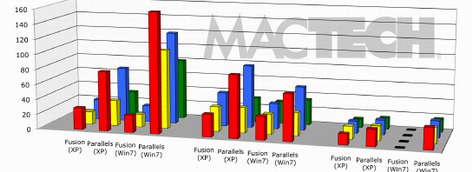Business
The latest head-to-head comparison between Windows virtualization solutions for the Mac
In its latest Head-to-Head: Parallels Desktop for Mac vs. VMware Fusion article, MacTech said it performed more than 3500 tests on both single- and multiprocessor desktop and mobile Mac models. The study looked at the two main virtualization solutions on the market, as well as both 32-bit and 64-bit performance of Windows XP and Windows 7 in the virtual machines.


To be clear, this article is not a product review; it's a benchmarking analysis (although we were morally obligated to comment on some of the 3D graphics and games ). The article's purpose is to assess performance (including issues we found if something didn't work right), and not product features, user interface, etc... You should use feature and support information in conjunction with the below benchmarking results to make your product choice.In addition, performance isn't everything to your workflow. Each of the virtualization solutions brings a different perspective to moving between Mac and Windows environments, and VMware with its set of virtualized applications may fit in better to some organizations. However, in some benchmarks, for the moment (until the next rounds of updates), Parallels is beating Fusion on a number of speed tests, especially for file and network I/O and game performance. It appears at the moment that Parallels is taking better advantage of hardware acceleration when it's available. But the virtualization is vastly improved from the emulation days on the PowerPC, MacTech reminds us.
One of the most interesting things in the virtualization market is how little overhead virtualization takes today compared to what it used to. To assess this, we measured in a variety of ways. Specifically, we focused on CPU usage (overall for the Mac), and how long the battery would last. CPU and memory usage were measured using "top" (a command line tool that's part of UNIX with a minimum of 50 continuous samples averaged for the result). [...] For the two idle tests, both virtualized environments did very, very well with only 2-5% of the CPU being used. So, while one may be 1/4 faster, it's not a significant difference to the user in real terms.What struck me from a once-over of the data sets is how much better performance is gained from the Mac Pro. Listen, if you want speed, that's where you want to look. Yes, a MacBook Pro, for most tests, is faster than a plain MacBook. But don't think that you're getting desktop performance from a "mobile desktop." You ain't.